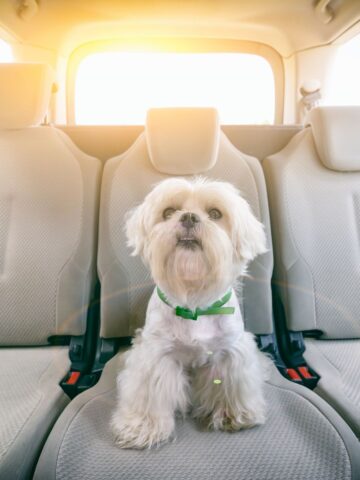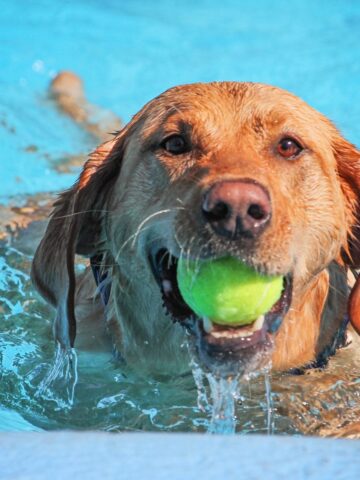Paws to Safety - Tips for Keeping Dogs Safe in the Pool
Summer is the perfect season for pool parties and outdoor fun. However, as much as we enjoy taking a dip in the pool, it's important to keep our furry friends safety in mind.
Dog's are naturally drawn to water, but not all dogs are strong swimmers, and accidents can happen even in the shallow end of the pool.
As dog owners, we'll want to make sure our dogs are safe around water and avoid any potential dangers or accidents.
In this blog post, we'll discuss some essential pool safety tips for dogs to help keep them safe and happy during your next summer pool party.
We'll cover everything from pool fencing and doggie life jackets to pool chemical safety and the importance of teaching your dog how to swim.
Plus, we'll share some common pool hazards to watch out for, such as slippery pool decks and pool covers.
With these tips, you can enjoy a fun and safe summer with your dogs.

1. Never Leave Dogs Unattended Poolside
One of the most important pool safety tips for dogs to keep in mind is to never leave your dog alone by the pool.
This is because dogs can easily fall into the pool, and they may not be able to swim back to the edge.
Even if your dog is a strong swimmer, accidents can happen, and you'll want to be there to intervene if needed.
Dog's also want to drink the pool water, which can be harmful to their health.
So, always supervise your pet when they are near the pool, and make sure to keep them away from the edge of the pool when you cannot be there to supervise.
Disclosure: Some of the links in this article are affiliate links (Amazon Associate or other programs we take part in). As an Amazon Associate, I earn a small commission from qualifying purchases.
2. Teach your Dog How to Swim
Swimming can be a fun and refreshing activity for dogs during hot summer days. However, not all dogs are natural swimmers, and teaching them to swim properly is essential for their safety.
- Start by introducing your dog to the shallow water and allow them to become comfortable with the sensation of being in the water.
- Gradually move to deeper water while offering encouragement and praise.
It's important to never force your dog to swim or leave them unattended in the water.
Consider using a dog life jacket for added safety and as a training tool.
With patience and practice, your dog can become a confident and safe swimmer.
3. Provide Easy Entrance and Exits for your Dog
Ensure that your pool has easily accessible entrances and exits for your dog.
Dog's can become disoriented or tired while swimming, so having designated pool ramps, steps, or a beach entry can make it easier for them to exit the water.
Train your dog to use these exit points consistently to help them feel confident and secure when entering and exiting a pool.
4. Provide Fresh Drinking Water
Always provide fresh drinking water for your dog near the pool area.
Drinking pool water can lead to health issues, and dehydration can occur quickly, especially in hot water.
Encourage your dog to drink from their designated water bowl to keep them hydrated and discourage them from drinking the pool water.

5. Invest in a Doggie Lifejacket
Investing in a dog lifejacket can ensure the safety of your dog.
Dog's like humans, can tire or struggle in the water, making it difficult for them to float.
- A well-fitting lifejacket can give your dog the support they need to stay safe and comfortable while swimming.
- It's important to choose a lifejacket that fits your dog properly and provides adequate buoyancy, as a poorly fitted lifejacket can actually be more dangerous than none at all.
- When purchasing a lifejacket, look for options with adjustable straps and flotation panels, and make sure to follow the manufacturer's instructions for sizing and use.
With a proper fitting lifejacket, you can give your pup the freedom to enjoy the water while staying safe and secure.
6. Teach the "Leave It" Command
Training your dog to respond to the "leave it" command near the pool is valuable when it comes to pool safety.
By teaching your dog to "leave" the pool area or ignore pool related hazards, you can redirect their attention and prevent them from jumping into the pool without supervision.
7. Rinse After Swimming
After each swimming session, rinse your dog with fresh water to remove any chlorine or pool chemicals that may irritate their skin or be harmful if ingested.
Pay particular attention to their ears, as trapped water can lead to ear infections.
Use a dog shampoo to keep their coat clean and healthy.
8. Install a Pool Fence
A sturdy pool fence can prevent your dog from accidentally falling into the water and potentially drowning.
- It's recommended to install a fence that is at least 4 feet high and has a self-closing and self-latching gate.
This will ensure that even if you forget to close the gate, it will automatically latch and prevent your dog from entering the pool area.
- Plus, make sure to regularly inspect the fence for any damages or weaknesses, and repair or replace any issues immediately.
By installing a pool fence you can help to keep your dog safe around the pool.
9. Keep Chemicals out of Reach
When having your dog in the pool, you'll want to think about the chemicals you use as well as how you're storing your chemicals.
It's important to keep your pool chemicals out of reach. Make sure that any pool chemicals such as chlorine, algaecide, and pH balancers are stored in a secure location away from your dog's reach.
- Ingesting pool chemicals can cause severe health problems such as vomiting, diarrhea, seizures, and even death.
After swimming make sure to rinse your dog off with clean water to remove any residual chemicals from their fur.
10. Avoid Pool Covers with Water
Pool covers can be hazardous to dogs, especially if they have water on them.
Dogs can be attracted to the water on the cover and attempt to drink from it, which can lead to an accidental drowning.
If a dog tries to walk on the pool cover with water may slip and fall into the pool, which can also result in drowning.
You'll always want to make sure that your pool cover is adequately drained and free from any water before letting your dog near it.
11. Keep Pool Deck Cool
The pool deck can get incredibly hot, which can cause discomfort or even burn your dog's paws.
- One way to do this is by using a pool deck cooling system or misters to keep the area comfortable and safe.
- You can also provide shade by setting up umbrellas or awning over the pool deck.
By keeping the pool deck cool and comfortable, you can help to prevent any injuries or discomfort for your dog while they enjoy a refreshing swim in the pool.
12. Maintain a First Aid Kit for Dogs
Having a first aid kit is an essential part of pool safety for dogs.
Accidents can happen at any time, and it's best to be prepared.
- A basic first aid kit should include items such as antiseptic solution, gauze pads, bandages, tweezers, and scissors.
In case of an emergency, having a first aid kit on hand can help you tend to your dog's injuries promptly and effectively.
It's best to maintain the first aid kit in a location that's easily accessible and to make sure all members of the household know where it is and how to use it.
A well-stocked first aid kit can make all the difference in an emergency, so it's best to be prepared.
13. Learn Basic Canine CPR
Being prepared for emergencies is crucial for your dog's safety around the pool.
- In addition to maintaining a first aid kit, consider learning canine CPR and first aid techniques, as they can save your dog's life in case of an accident.
Familiarize yourself with the necessary steps and have your veterinarians emergency contact numbers handy in case your should need to contact them quickly.
Final Thoughts on Pool Safety for Dogs
In conclusion, following the essential pool safety tips for dogs can make a big difference in keeping your pup safe while enjoying the water.
It's important to always supervise your dog when they're in or near the pool, provide them with appropriate doggie life jackets.
It's also important to train them how to safely enter and exit the pool.
By taking these measures, you can create a fun and safe environment for your dog to enjoy the water and prevent any potential accidents.
Remember, safety always comes first!






Leave a Reply